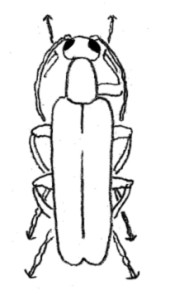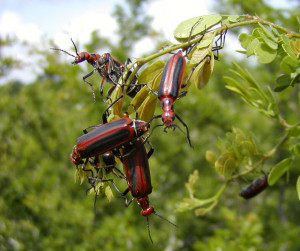
Their medium-large size, narrow, cylindrical “neck” or prothorax, and linear antennae help distinguish blister beetles.
This summer has been blistering in more ways than one. Besides the blistering temperatures, an inconspicuous beetle, called a blister beetle, has been more common than normal this year.
Several species of blister beetles are native to our area and cause concerns, especially to horse owners. Blister beetles are recognized by their medium to large size (usually 1-2 cm), rectangular head, cylindrical pronotum (the “neck” or portion of the thorax just behind the head), and often plump abdomen with leathery wings. One of the distinctive features of blister beetles is that the pronotum is narrow, narrower than either the head or the front edge of the abdomen. Some species, especially western U.S. species are brightly colored (aposematic coloration), but the more common eastern species are dull colored or black.
Blister beetles are so-named because of their special chemical defense mechanism. The blood of blister beetles contain a terpene called cantharidin. When it comes in contact with human skin, cantharidin causes a superficial blistering. It can also be highly toxic if ingested, for people and also especially for horses and poultry. For this reason horse owners are particularly sensitive to blister beetles in hay. Each year incidents occur where horses die after eating hay in which blister beetles were inadvertently baled.
For this reason, blister beetles are one of several insects covered in the 2009 publication E-238, Managing Insect and Mite Pests of Texas Forage Crops. This publication provides cautionary advice to horse owners and the fatal number of different beetle species to horses. In addition the Texas Veterinary Medicine and Diagnostic Laboratory has a factsheet on diagnosing cantharidin poisoning.

These blister beetles (Pyrota sp.) were observed in June 2005 in Goliad county by Lee Elliot of San Antonio. He estimated 10,000 or more beetles were aggregated on trees over a couple of acres. The red and black coloration is a warning to predators of their toxic nature.
Blister beetles are sometimes seen on garden plants or gathered in large aggregations on native plants or trees. If you come across these beetles in the wild, they may make a great insect collection specimen; but exercise caution when handling. Blister beetle larvae feed on underground nests of native bees and on grasshopper eggs.